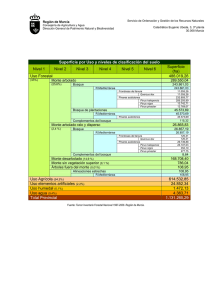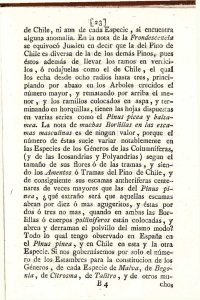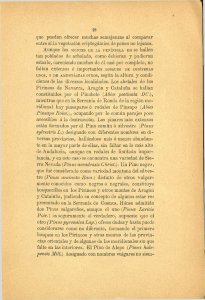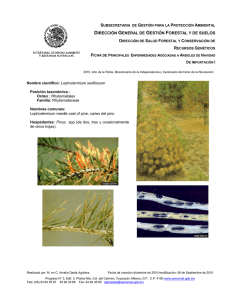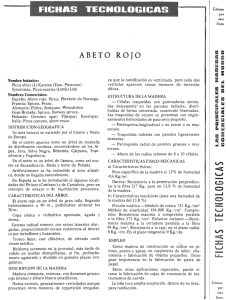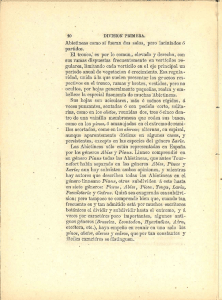Pinares mediterráneos de pinos mesogeanos endémicos
Anuncio
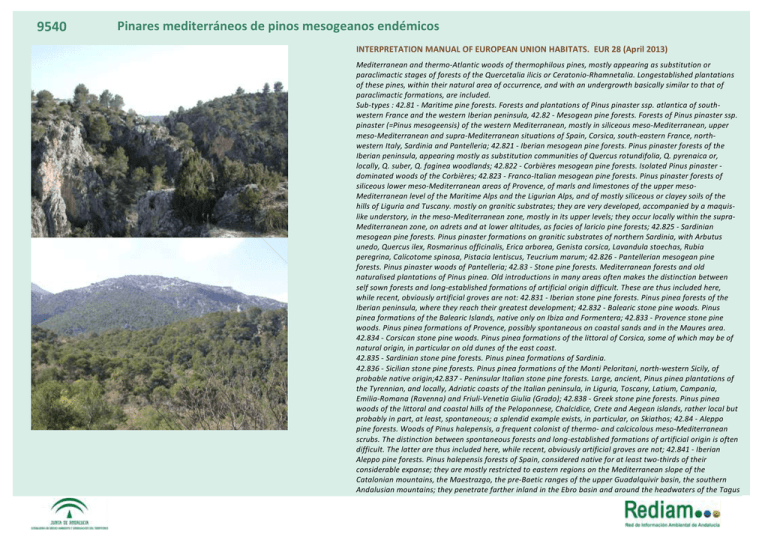
9540 Pinares mediterráneos de pinos mesogeanos endémicos INTERPRETATION MANUAL OF EUROPEAN UNION HABITATS. EUR 28 (April 2013) Mediterranean and thermo-Atlantic woods of thermophilous pines, mostly appearing as substitution or paraclimactic stages of forests of the Quercetalia ilicis or Ceratonio-Rhamnetalia. Longestablished plantations of these pines, within their natural area of occurrence, and with an undergrowth basically similar to that of paraclimactic formations, are included. Sub-types : 42.81 - Maritime pine forests. Forests and plantations of Pinus pinaster ssp. atlantica of southwestern France and the western Iberian peninsula, 42.82 - Mesogean pine forests. Forests of Pinus pinaster ssp. pinaster (=Pinus mesogeensis) of the western Mediterranean, mostly in siliceous meso-Mediterranean, upper meso-Mediterranean and supra-Mediterranean situations of Spain, Corsica, south-eastern France, northwestern Italy, Sardinia and Pantelleria; 42.821 - Iberian mesogean pine forests. Pinus pinaster forests of the Iberian peninsula, appearing mostly as substitution communities of Quercus rotundifolia, Q. pyrenaica or, locally, Q. suber, Q. faginea woodlands; 42.822 - Corbières mesogean pine forests. Isolated Pinus pinaster dominated woods of the Corbières; 42.823 - Franco-Italian mesogean pine forests. Pinus pinaster forests of siliceous lower meso-Mediterranean areas of Provence, of marls and limestones of the upper mesoMediterranean level of the Maritime Alps and the Ligurian Alps, and of mostly siliceous or clayey soils of the hills of Liguria and Tuscany. mostly on granitic substrates; they are very developed, accompanied by a maquislike understory, in the meso-Mediterranean zone, mostly in its upper levels; they occur locally within the supraMediterranean zone, on adrets and at lower altitudes, as facies of laricio pine forests; 42.825 - Sardinian mesogean pine forests. Pinus pinaster formations on granitic substrates of northern Sardinia, with Arbutus unedo, Quercus ilex, Rosmarinus officinalis, Erica arborea, Genista corsica, Lavandula stoechas, Rubia peregrina, Calicotome spinosa, Pistacia lentiscus, Teucrium marum; 42.826 - Pantellerian mesogean pine forests. Pinus pinaster woods of Pantelleria; 42.83 - Stone pine forests. Mediterranean forests and old naturalised plantations of Pinus pinea. Old introductions in many areas often makes the distinction between self sown forests and long-established formations of artificial origin difficult. These are thus included here, while recent, obviously artificial groves are not: 42.831 - Iberian stone pine forests. Pinus pinea forests of the Iberian peninsula, where they reach their greatest development; 42.832 - Balearic stone pine woods. Pinus pinea formations of the Balearic Islands, native only on Ibiza and Formentera; 42.833 - Provence stone pine woods. Pinus pinea formations of Provence, possibly spontaneous on coastal sands and in the Maures area. 42.834 - Corsican stone pine woods. Pinus pinea formations of the littoral of Corsica, some of which may be of natural origin, in particular on old dunes of the east coast. 42.835 - Sardinian stone pine forests. Pinus pinea formations of Sardinia. 42.836 - Sicilian stone pine forests. Pinus pinea formations of the Monti Peloritani, north-western Sicily, of probable native origin;42.837 - Peninsular Italian stone pine forests. Large, ancient, Pinus pinea plantations of the Tyrennian, and locally, Adriatic coasts of the Italian peninsula, in Liguria, Toscany, Latium, Campania, Emilia-Romana (Ravenna) and Friuli-Venetia Giulia (Grado); 42.838 - Greek stone pine forests. Pinus pinea woods of the littoral and coastal hills of the Peloponnese, Chalcidice, Crete and Aegean islands, rather local but probably in part, at least, spontaneous; a splendid example exists, in particular, on Skiathos; 42.84 - Aleppo pine forests. Woods of Pinus halepensis, a frequent colonist of thermo- and calcicolous meso-Mediterranean scrubs. The distinction between spontaneous forests and long-established formations of artificial origin is often difficult. The latter are thus included here, while recent, obviously artificial groves are not; 42.841 - Iberian Aleppo pine forests. Pinus halepensis forests of Spain, considered native for at least two-thirds of their considerable expanse; they are mostly restricted to eastern regions on the Mediterranean slope of the Catalonian mountains, the Maestrazgo, the pre-Baetic ranges of the upper Guadalquivir basin, the southern Andalusian mountains; they penetrate farther inland in the Ebro basin and around the headwaters of the Tagus and Guadalquivir systems; 42.842 - Balearic Aleppo pine forests. Pinus halepensis formations of the Balearics, present and probably native on all the major islands; 42.843 - Provenço-Ligurian Aleppo pine forests Mostly lower meso-Mediterranean Pinus halepensis forests of Provence and of the lower slopes and coastlines of the Maritime and Ligurian Alps, extensive and undoubtedly native; 42.844 - Corsican Aleppo pine woods. Rare and local Pinus halepensis woods of the Corsican coasts, some, at least, possibly natural; 42.845 - Sardinian Aleppo pine woods. Pinus halepensis formations of Sardinia, where certainly native woods occur on Isola di San Pietro and the Sulcis coast of Iglesiente; 42.846 - Sicilian Aleppo pine woods. Pinus halepensis formations of Sicily and peripheral islands (Egadi, Lampedusa, Pantelleria); 42.847 - Peninsular Italian Aleppo pine forests Pinus halepensis formations of the Italian peninsula; extensive, probably at least partially native ones are individualised in the subdivisions below; 42.848 - Greek Aleppo pine forests Pinus halepensis formations of Greece, where the species is relatively widespread, particularly in Attica, Thessaly, the coasts of the Peloponnese and of central continental Greece, the Ionian islands, Chalcidici, the northern Sporades, Euboea and Skiros. 42.85 - Aegean pine forests. Pinus brutia forests of Crete and eastern Aegean islands. Eastern vicariants of Aleppo pine forests (42.84), they comprise, however, taller, more luxuriant, and often extensive, formations. Disjunct formations of this pine or of related species, described from Crimea and the Caucasian region (Pinus pityusa, Pinus stankewiczii, Pinus eldarica) have been included.. 42.851 - Aegean pine forests of Crete. Pinus brutia-dominated forests of Crete and its satellite islands Gavdos and Gaidaronisi, pure or mixed with Cupressus sempervirens; they are widespread in particular in the White Mountains, the Psiloriti range, the Dikti range and, locally, in the Sitia mountains and the Asterousia mountains. 42.852 - Aegean pine forests of Lesbos. Extensive Pinus brutia forests of Lesbos, occupying Mount Olympus and surrounding hills in the south-eastern quadrant of the island, as well as parts of the Kuratsonas range in the north-west; these forests harbour the only European population of the nuthatch Sitta krueperi and the most significant one of the orchid Comperia comperiana; 42.853 - Aegean pine forests of Samos. Pinus brutia forests covering large expanses of Samos, in particular in the Ambelos range, the Kerki mountains, the southern hills and the north-eastern peninsula; 42.854 - Aegean pine woods of Chios. Remnant forests of Chios with a composition and stratification similar to those of the forests of Samos; 42.855 - Aegean pine forests of Thasos. Broad Pinus brutia belt on the lower reaches of Thasos, up to about 400 to 500 metres, mixed with Pinus pallasiana in the higher areas; 42.856 - Aegean pine woods of Samothrace. Mostly sparse Pinus brutia formations of the lowlands of Samothrace; 42.857 - Aegean pine forests of Rhodes. Remnant Pinus brutia forests of Rhodes, still represented by some relatively natural formations with rich scrub undergrowth; 42.858 Aegean pine forests of Karpathos. Fairly extensive Pinus brutia forests of Karpathos, distributed, in particular, in the northern coastal area, the southern interior and the middle elevation of Kali Limni; 42.859 - Aegean pine forests of the Dodecanese. Pinus brutia formations of the islands of Simi, Kos, Leros and Ikaria. Especies Pinus pinaster ssp. atlantica, Pinus pinaster ssp. pinaster (=Pinus mesogeensis), Pinus pinea, Pinus halepensis, Pinus brutia. Diagnosis En este hábitat se incluyen formaciones dominadas por 3 especies de pinos de marcado carácter mediterráneo (Pinus halepensis, P. pinea y P. pinaster), de las que, en Andalucía, únicamente encontramos las formadas por pino carrasco (P. halepensis) , que constituyen pinares-sabinares situados en zonas de alta xericidad, generalmente del interior de los territorios béticos, y las formadas por pino resinero (P. pinaster subsp. acutisquama) que corresponden bien a un pinar-coscojar asociados a rocas serpentínicas y peridotíticas, o bien a pinaressabinares abiertos sobre arenas dolomíticas, propios de las Sierras de Tejeda y Almijara. Las formaciones de pino piñonero sobre dunas y arenas litorales corresponden al HIC 2270, y el resto de los pinares de piñonero se consideran fuera de su área de distribución natural y por tanto, no se incluyen en ningún HIC. De manera general estas formaciones se presentan como manchas de matorral más o menos denso sobre el que se presenta un estrato arbóreo de pinar de cobertura media. Los pinares-sabinares de P. halepensis son formaciones edafoxerófilas propias de calizas y dolomías, donde Juniperus phoenicea (sabina mora), Rhamnus lycioides, Juniperus oxycedrus, Rhamnus myrtifolius, Echinospartum boissieri, Thymus orospedanus o Fumana paradoxa son especies comunes. El pinar-coscojar de pino resinero, propio de serpentinas y peridotitas, se caracteriza por las especies Quercus coccifera, Juniperus oxycedrus, Staehelina baetica, Genista lanuginosa y Digitalis lacianiata, entre otras especies. Los pinares-sabinares de P. pinaster y Juniperus phoenicea (sabina mora), se desarrollan sobre dolomías triásicas, en su mayor parte kakiritizadas, que dan lugar a un paisaje de arenales y roquedos ruinosos fácilmente disgregables. Estos pinares se caracterizan por la presencia de Rhamnus myrtifolius y Juniperus oxycedrus en el estrato arbustivo. En estos ambientes boscosos es frecuente la aparición de un variado conjunto de aves paseriformes forestales, como carboneros y herrerillo (Parus sp.), así como de mamíferos como el gato montés (Felis silvestris), el meloncillo (Herpestes ichneumon) y la gineta (Genetta genetta). Interpretación Este HIC se considera fundamentalmente fitocenológico. Son formaciones de Pinus halepensis, o P. pinaster, donde la cobertura del arbolado supera el 30 (-25) % de la ocupación en la unidad territorial considerada y está acompañada de un estrato arbustivo característico del tipo de bosque que se trate (presencia de la asociación vegetal definitoria), con una ocupación significativa. Los pinares de repoblación son consideradas como hábitat de interés comunitario cuando se correspondan con formaciones maduras, con sotobosque desarrollado, donde ya no es apreciable el marco de plantación y se encuentren dentro de su área natural de distribución. Las comunidades características de estos HICs pueden presentar estructura de pinar, correspondiente al HIC 9540, o bien de matorral (coscojares o sabinares según la comunidad de que se trate), correspondiendo en este caso a los HICs de matorral 5210 (sabinares) o 5330_7 (coscojares). Respecto a las formaciones de pinos piñoneros, en Andalucía solo se consideran HICs las que se desarrollan sobre arenas y dunas litorales, que se incluyen en el HIC 2270. Variabilidad La diversidad de sustratos sobre los que se desarrolla el hábitat, de especie de pinos y comunidades vegetales características, de condiciones ecológicas y biogeográficas condicionan la alta variabilidad que presenta este HIC tanto de manera general como en nuestra comunidad. Distribución en España Los bosques de pino carrasco son característicos de climas cálidos y secos de la mitad oriental peninsular y de Baleares, casi siempre en sustratos básicos y por debajo de 800 m de altitud. Las formaciones de pino resinero se localizan en arenales y roquedos más o menos ácidos de casi toda la Península, siendo más raros en el nordeste y suroeste. Los pinares de pino piñonero se localizan fundamentalmente en la Meseta norte, Sistema Central, la Mancha, interior de Cataluña y Baleares. Distribución en Andalucía Los pinares de Pinus halepensis se localizan en la vertiente costera de algunas montañas del sur de Andalucía (por ejemplo, sierras de Tejeda y Almijara), desde el nivel del mar hasta los 700 m de altitud, sobre sustratos calcáreos y dolomíticos, así como al sur de las montañas de Segura y Cazorla, desde Sierra Mágina, en Jaén, hasta la provincia de Murcia, entre 500 y 800 m de altitud, sobre margas, calcáreas o no, e incluso yesos. Los pinares de Pinus pinaster se localizan bien sobre dolomías del sector bético oriental, fundamentalmente Sierra Tejeda y Almijara, o bien sobre peridotitas del sector occidental malacitano, sobre sustratos serpentínicos, de la zona suroccidental de la provincia de Málaga (Sierra Bermeja, Sierra de las Nieves, Sierra de la Alpujata, Sierra de Carratraca,…). También aparece una reducida representación en las areniscas oligocenas del Aljibe (Cádiz). Ir al WMS http://www.juntadeandalucia.es/medioambiente/site/rediam/menuitem.04dc44281e5d53cf8ca78ca731525ea0/?vgnextoid=ede4fb460bbd0410VgnVCM1000001325e50aRCRD&vgnextchann Relación con "A classification of Palaearctic habitats" 1995 version . Para la dsitribución total del HIC. 42.8 Mediterranean pine woods 42.81 Maritime pine forests 42.814 Iberian maritime pine forests 42.82 Mesogean pine forests 42.821 Iberian mesogean pine forests 42.8211 Northern-Iberian mesogean pine forests 42.8212 Cordilleran mesogean pine forests 42.8213 Southern-Iberian mesogean pine forests 42.82131 Siliceous Southern-Iberian mesogean pine forests 42.82132 Calcicolous Southern-Iberian mesogean pine forests 42.8214 Cazorlan mesogean pine forests 42.8215 Southern Andalusian mesogean pine forests 42.82151 Aljibe mesogean pine forests 42.82152 Andalusian peridotite mesogean pine forests 42.82153 Andalusian dolomite mesogean pine forests 42.82154 Eastern Andalusian calcicolous mesogean pine forests 42.82155 Eastern Andalusian silicicolous mesogean pine forests 42.8216 Leonese mesogean pine forests 42.8217 Catalonian mesogean pine forests 42.829.ES Repoblaciones de Pinus pinaster en el entorno de su área natural 42.83 Stone pine forests 42.831 Iberian stone pine forests 42.8311 Western Andalusian stone pine forests 42.8313 Castilian stone pine forests 42.8314 Cordilleran stone pine forests 42.8315 Catalonian stone pine forests 42.8316 Morena stone pine forests 42.8317 Manchegan stone pine forests 42.832 Balearic stone pine woods 42.84 Aleppo pine forests 42.841 Iberian Aleppo pine forests 42.8411.ES Pinares de pino carrasco (Pinus halepensis) con sotobosque de lentisco (Pistacia lentiscus), aladierno (Rhamnus alaternus), Phillyrea spp. y lianas, de óptimo litoral 42.8412.ES Pinares de pino carrasco (Pinus halepensis) con sotobosque de coscoja (Quercus coccifera) 42.8413.ES Pinares de pino carrasco (Pinus halepensis) con sotobosque de maquias de carrasca (Quercus rotundifolia) 42.8414.ES Pinares de pino carrasco (Pinus halepensis) con sotobosque de matorrales calcícolas, de óptimo litoral 42.8415.ES Pinares de pino carrasco (Pinus halepensis) con sotobosque de matorrales calcícolas, continentales 42.8416.ES Pinares de pino carrasco (Pinus halepensis) con sotobosque de matorrales silicícolas 42.8417.ES Repoblaciones de Pinus halepensis en el entorno de su área natural 42.8418.ES Pinares de pino carrasco (Pinus halepensis), con sotobosque de Ampelodesmos mauritanica 42.842 Balearic Aleppo pine forests 42.84B North African Aleppo pine forests Relación con la Lista Patron Española de Hábitats Terrestres (En estudio). Para los habitats presentes en Andalucía. 4 BOSQUES 42 BOSQUES DE CONÍFERAS 42.8 Pinares termófilos mediterráneos y atlánticos 42.82 Pinares de Pinus pinaster mediterráneos 42.821 Pinares de Pinus pinaster de la Península Ibérica 42.8215 Pinares de pino resinero (Pinus pinaster) del sur de Andalucía 42.82152 Pinares de pino resinero (Pinus pinaster) sobre peridotitas 42.82153 Pinares de pino resinero (Pinus pinaster) sobre dolomías 42.84 Pinares de pino carrasco (Pinus halepensis) 42.841 Pinares de pino carrasco (Pinus halepensis) de la Península Ibérica Relación con EUNIS habitat classification 2007. Para los habitats presentes en Andalucía. G Woodland, forest and other wooded land G3 Coniferous woodland G3.7 Lowland to montane mediterranean [Pinus] woodland (excluding [Pinus nigra]) G3.72 [Pinus pinaster ssp. pinaster] ([Pinus mesogeensis]) forests G3.721 Iberian mesogean pine forests G3.7215 Southern Andalusian mesogean pine forests G3.72152.ES Pinares de pino resinero (Pinus pinaster) sobre peridotitas G3.72153.ES Pinares de pino resinero (Pinus pinaster) sobre dolomías G3.74 [Pinus halepensis] forests G3.741 Iberian [Pinus halepensis] forests Entidades fitosociológicas relacionadas con el hábitat QUERCETEA ILICIS Pistacio lentisci-Rhamnetalia alaterni Ir a la ficha h h Pino acutisquamae-Juniperion phoeniceae Pino acutisquamae-Quercetum cocciferae h Pino acutisquamae-Quercetum cocciferae arbutetosum unedonis Rhamno myrtifolii-Juniperetum phoeniceae h Rhamno lycioidis-Pinetum halepensis h Comunidad de Pinus halepensis
